

How to Be a Hobo. Source: Life Am I the only boy who secretly dreamed of becoming a hobo?
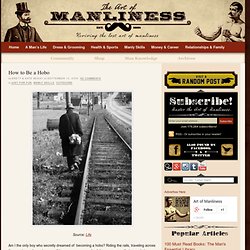
Riding the rails, traveling across the country, and carrying everything you own on your back has a romance that appeals to every man’s desire to wander. In a 1937 issue of Esquiremagazine, an anonymous writer penned an article called “The Bum Handbook.” Unlike most bums, he had chosen his vagabond lifestyle. And he was tired of seeing the sub-par job most other bums were doing.
Although much has changed since the 1930′s, if you by chance find yourself a hobo during this Great Recession or desire to become a bum by choice, perhaps you can learn some tips from hobos of old. Keep yourself clean. Stay away from the cities. Avoid intermediaries. Travel the World for Free. How To Eat On The Cheap.
If you want to learn how to eat cheap or even free while on the road, you must have an open mind and a sauce made of hunger.

It’s really not as hard as you may think though and you may actually form some habits, though not always legal ones, that could save you thousands when you return home. Eat For Cheap One of a travelers biggest expense is food. In this guide I will teach you the techniques that will enable you to cut your food costs and prolong your adventure indefinitely. The first section will covers some simple ways that you can enhance the value of your dollar. Punk Rafting - Adventuring by Wes Modes. In 2005, a few of us set out on a punk rafting adventure, building a raft out of found and scavenged materials and floating for a week, Huck Finn-style, on one of the largest fastest rivers on the continent, the Missouri.

We lived to tell the tale (barely), and so year after year, we’ve taken longer and longer adventures, floating many major American rivers on completely ridiculous homemade rafts. After that first single raft trip, we invited others, launching with whole punk raft flotillas. The experience has been life changing. Below are two ‘zines created by the author: The Good Ship Abandonthe story so far A graphic adaption of an adventure building a raft out of trash and floating more than a hundred miles on the perilous Missouri River, one of the fastest flowing rivers in North America.Punk Rafting Adventureyours for the taking A ‘zine in preparation for a journey with friends on the Willammette River based on a half decade of DIY river rafting.
Wishing to train hop... needing advice. - Train Hopping - tribe.net. You definitly need a crew change.
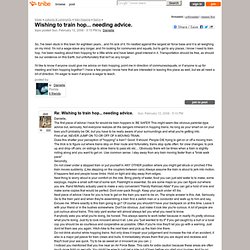
There is some great advice in there, as well as it being like a bus schedule for trains....as much fun as it is to be spontanius, you dont want to be on a hotshot going straight to Northern Canada without any breaks, and there are certain cities you want to avoid, especialy in Texas and around military basses. Also Los Angeles and New York. Trainhopping. Day One: Mile 0, Vancouver, British Columbia Today is the day.
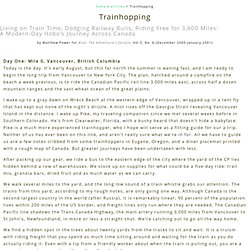
It's early August, but this far north the summer is waning fast, and I am ready to begin the long trip from Vancouver to New York City. The plan, hatched around a campfire on the beach a week previous, is to ride the Canadian Pacific rail line 3,000 miles east, across half a dozen mountain ranges and the vast wheat ocean of the great plains. I wake up to a gray dawn on Wreck Beach at the western edge of Vancouver, wrapped up in a tent fly that has kept out none of the night's drizzle. A mist rises off the Georgia Strait revealing Vancouver Island in the distance. I wake up Pike, my traveling companion since we met several weeks before in Southern Colorado. 4 lessons learned from the vagabond life. I struggled to define myself.
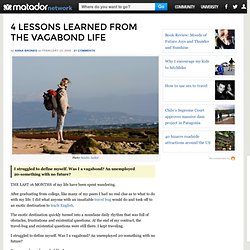
Was I a vagabond? An unemployed 20-something with no future? THE LAST 16 MONTHS of my life have been spent wandering. After graduating from college, like many of my peers I had no real clue as to what to do with my life. I did what anyone with an insatiable travel bug would do and took off to an exotic destination to teach English. The exotic destination quickly turned into a mundane daily rhythm that was full of obstacles, frustrations and existential questions. Life lessons are the most important thing we can bring back with us from our travels Some people made me feel like I needed to define a goal for myself, so that all this traveling and wandering would lead to something concrete.
16 Ways To Get Paid To Travel. Railway renegades / Despite the real perils, train-hopping is catching on again. Nothing can prepare you for hopping your first freight train.

The ground vibrates, you hear that lonesome whistle blow, and a wall of noise hits you like a tidal wave: groaning, screeching cars, steel wheels scraping against tracks, your partner yelling in your ear, "There's your car, go for it! " I almost lost my foot on my maiden voyage (couldn't find the bottom rung of the ladder that hangs from the back of the grainer), but my heroic partner, a man I'd never met before, grabbed me by the seat of my pants and hoisted my body 4 feet in the air, while running behind me at train speed.
Eight years and several thousand miles of rail later, I still thank him regularly. How To Hop a Freight Train by Wes Modes. By Wes Modes Originally published in Might magazine, October 1994 What to Worry About Safety is a big deal on the railroad.
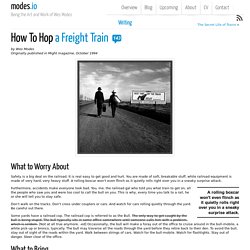
It is real easy to get good and hurt.